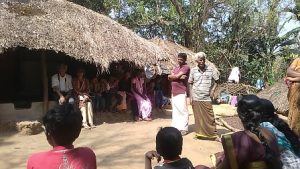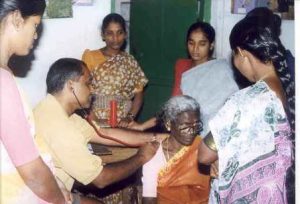Vacuum in Tribal Health
Many Indian mythological and historical stories have shown us that they were the strongest fighters in the dense forests, assisting many kings who went to wars to the destination of victory.

Designing a story around the superpowers of these forest dwellers have been a part of Indian culture for a very long time. However, the condition has changed in the Modern world, where tribal people have the poorest health status and they carry a triple burden of disease, as stated by Ashwini Kumar Choubey, Minister of State, Ministry of Health and Family Welfare (MoHFW), while answering to a question asked by Dr Sanjay Jaiswal, MP, about the tribal health infrastructure. Moreover, despite the high reliance of the tribal people on the public health care system in Scheduled Areas, it continues to be characterized by low output, low quality and low outcome delivery system, often targeting wrong priorities.
Alarmingly, almost 50 per cent of adolescent ST girls between the ages of 15–19 years are underweight or have a BMI of less than 18.5.
NHFS 4 pointed out that 59.8 per cent of tribal women in the 15–49 years age group suffer from anaemia as against 53 per cent other (non-SC, ST) women. There is an upward progression in this case if compared to NHFS-3, but the situation still remains as grave as more than half of the female population is affected; which in turn affects the children as well.
The Rapid Survey of Children (2013–14) showed that the highest percentage of children with low birth weight (less than 2.5 kg) was found among the tribal population. There are huge disparities between the nutritional status of tribal children and those belonging to non-tribal, except in north-eastern states.
Also Read : Lack Of Rural Healthcare Story Of Bihars Phag
The percentage of ST children underweight has reduced from 54.5 per cent in NHFS-3 (2005–06) to 42 per cent in NHFS-4 (2015–16). However, compared to other social groups, tribal children continue to be the most malnourished. The prevalence of underweight is almost one and a half times in tribal children than in the other castes.
With 45.3 per cent rural ST population living Below Poverty Line (BPL) with 24.1 urban ST populations in tow demands for desperate and effective measures to provide adequate nutrition amongst the tribal. As in the general child population, under-nutrition among tribal children increases with age. The prevalence of underweight and stunting was higher among preschool children compared to infants. The food intake and the intake of various nutrients such as proteins, calories and vitamins have decreased in the last decade in the tribal population.
Lack of community participation in planning, designing and implementation of health services according to specific needs have adverse effects on government schemes. There is a visible low rate of policy response and this isolation has increased the dependency of tribals on government schemes and programmes for the fulfilment of basic needs.
Many state High Courts have shown their displeasure over deaths of children due to malnutrition in tribal pockets of states.

While expressing in a strict tenor, Mumbai High Court rebuked the state government for being proud of the declining number of deaths due to malnutrition where even one death of an infant is a matter of shame for such a progressive state. The utilization of funding for the purpose has been questioned repeatedly in the past along with the knowledge of officials about the actual condition of the innermost parts of forests.
Displacement and prohibitory laws have restricted their movements into the natural spheres of food collection and sources of nutrition.The natural resources which were earlier used by the tribals have been restricted by the government for preservation. Unfamiliar conditions and lack of access to resources have rendered them without food which they were used to from the beginning.
Constitution of India granted tribals the undefined property rights because of the laws of India, but it has now been snatched the rights of tribals from obtaining their ancestral resources of food and nutrition. The shortfall of staff is higher in states with high tribal populations; for example, the shortfall for PHCs is 52 per cent in Rajasthan, 53 per cent in Madhya Pradesh, 58 per cent in Jharkhand, 36 per cent in Telangana and 30 per cent in Maharashtra.
Status of Health Infrastructures (SCs, PHCs and CHCs) in tribal areas as on March 2017(Tribal statistics 2017)
| Tribal population in Rural areas | Sub Centres | PHCs | CHCs | ||||||
| R | P | S | R | P | S | R | P | S | |
| 93,819,162 | 31,273 | 28,200 | 6,503 | 4,690 | 4,024 | 1,240 | 1,172 | 1,028 | 273 |
In an answer given by Ashwini Kumar Choubey on 12 July 2019 in Lok Sabha about the tribal health infrastructure as on March 2018, the following data was provided:
| Tribal population in Rural areas | Sub Centres | PHCs | CHCs | ||||||
| R | P | S | R | P | S | R | P | S | |
| 93,819,162 | 31,257 | 28,091 | 5,935 | 4,675 | 3,971 | 1,187 | 1,156 | 1,017 | 275 |
Note: R: Required; P: In Position; S: Shortfall
The data provided by government sources clearly points out where the problems lie. The decreasing number of in-position health centres along with the reduction in estimate number of centres required by tribal population whereas the population data remains unchanged.
As per the Rural Health Statistics, there has been a whopping 63.75 per cent increase in the number of health infrastructures with 20,200 in 2005 to 33079 in 2018.
Allocation of funds under Scheduled Tribal Sub-Plan in respect of major health schemes/programme
| S.No. | Financial Year | Allocation of funds (In rupees crores) |
| 1. | 2016–17 | 2,572.19 |
| 2. | 2017–18 | 2,971.86 |
| 3. | 2018–19 | 3,382.32 |
Minister of State, MoHFW while answering a question related to health indicators of tribals stated that under the National Health Mission, financial and technical support is provided to the states/UTs to strengthen their health care systems for the provision of equitable, affordable healthcare to all its citizens, particularly the poor and vulnerable population including tribal population-based on requirement posed by the States in their Programme Implementation Plans (PIPs).
Also Read : Over Prescription Of Antibiotics A Profitable Business In India
Under NRHM, tribal areas enjoy relaxed norms for setting up public health facilities including ‘time to care’ norm for setting up sub-health centres in tribal areas within 30 minutes of walk from habitation and relaxed norm for Mobile Medical Units for tribal areas; extra one MMU if it exceeds 30 patients per day against 60 patients per day in plain areas for bringing healthcare delivery to the doorsteps of the population.
Some of the states are trying to battle the situation with schemes specially designed for tribal people. In Maharashtra, APJ Abdul Kalam Amrut Aahaar Yojana provides a full meal for pregnant women and lactating mothers, whereas Village Child Development Centres assist the children suffering from malnutrition.
There is a need to mend the gap between policymakers and the community. The establishment of a coordinated strategy on the government’s side (with effective implementation) along with encouraged increased participation from the receivers’ part might help the tribals in growing into a healthy community again. Developing functioning health infrastructures with a steady presence of personnel can also help in improvement.
